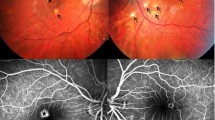Abstract
Purpose
To discuss the effect and outcome of a combined intravitreal triamcinolone acetonide (IVTA) injection with intravitreal bevacizumab (IVB) in treating choroidal neovascularization (CNV) associated with large retinal pigment epithelial detachment (PED) in age-related macular degeneration (AMD).
Design
Prospective, consecutive, observational case series.
Methods
Seven eyes (five patients) with CNV associated with large PED in AMD were treated by IVTA (4 mg/ 0.1 ml), followed by a IVB (1.25 mg/0.05 ml) 1 week later. Patients were evaluated for best-corrected visual acuity (BCVA) and optical coherence tomography (OCT) at baseline, at 1 week and every 6 weeks. Fluorescein angiography (FA) and indocyanine green angiography (ICG) were performed at baseline and every 3 months afterwards. Indications for retreatment by combined injection were defined as persistent PED with subretinal and/or intraretinal fluid on OCT. Patients with flattening of the PED and activity leakage demonstrated by OCT underwent subsequent IVB.
Results
The mean duration of follow-up was 11 months (range 9–14 months). BCVA at baseline averaged 20/125, and 20/80 at the end of follow-up. FA showed no leakage from the lesion in four eyes at the end of follow-up, and three eyes showed a decrease in leakage. Average central foveal thickness was (CFT) 325.7 microns at baseline and 209.2 microns at the end. The average size of the PED was 2.34 disk diameters (range 1.33–3.25) at baseline, and the PED disappeared in four eyes, while it decreased in size at the end in the remaining three. The subretinal fluid disappeared in all patients at the end. The combined treatment (IVTA with IVB 1 week later) was repeated in four eyes, and the number of IVB after combined injection ranged from one to three. No RPE tear appeared during follow-up. Two eyes developed glaucoma controlled by topical medication. There were no other ocular or systemic complications
Conclusion
Combined IVB and IVTA therapy seems to be an effective and safe procedure to treat CNV associated with large PED in AMD.


Similar content being viewed by others
References
Slakter JS, Yannuzzi LA, Sorenson JA et al (1994) A pilot study of indocyanine green videoangiography-guided laser photocoagulation treatment of occult choroidal neovascularization in age-related macular degeneration. Arch Ophthalmol 112:465–472
Ladas ID, Kotsolis AI, Rouvas AA et al (2007) Efficacy of photodynamic therapy in the management of occult choroidal neovascularization associated with serous pigment epithelium detachment. Ophthalmologica 221(5):313–319
Augustin AJ, Puls S, Offermann I (2007) Triple therapy for choroidal neovascularization due to age-related macular degeneration: verteporfin PDT, bevacizumab, and dexamethasone. Retina 27(2):133–140
Haines JL, Hauser MA, Schmidt S et al (2005) Complement factor H variant increases the risk of age-related macular degeneration. Science 308:419–421
Edwards AO, Ritter R 3rd, Abel KJ, Manning A, Panhuysen C, Farrer LA (2005) Complement factor h polymorphism and age-related macular degeneration. Science 308:421–424
Ruiz Moreno JM, Montero J, Barile S, Zarbin M (2006) Photodynamic therapy and high-dose intravitreal triamcinolone to treat exsudative age-related macular degeneration. 1-year outcome. Retina 26:602–612
Ahmadieh H, Taei R, Soheilian M et al (2007) Single-session phototherapy therapy combined with intravitreal bevacizumab and triamcinolone for neovascular age-related macular degeneration. BMC Ophthalmol 7:10
Avery RL, Pieramici DJ, Rabena MD et al (2006) Intravitreal bevacizumab (Avastin) for neovascular age-related macular degeneration. Ophthalmology 113:363–372
Arevalo JF, Fromow-Guerra J, Sanchez JG, Maia M, Berrocal MH, Wu L, Saravia MJ, Costa RA (2008) Primary intravitreal bevacizumab for subfoveal choroidal neovascularization in age-related macular degeneration: results of the Pan-American Collaborative Retina Study Group at 12 months follow-up. Retina 28(10):1387–1394
Meyer CH, Mennel S, Schmidt JC, Kroll P (2006) occult choroidal neovascularisation secondary to intravitreal bevacizumab (Avastin) injection for Acute retinal pigment epithelial tear following age related macular degeneration. Br J Ophthalmol 90(9):1207–1208
Spaide RF (2006) Rationale for combination therapies for choroidal neovascularization. Am J Ophthalmol 141:149–156
Ciulla TA, Criswell MH, Danis RP et al (2001) Intravitreal triamcinolone acetonide inhibits choroidal neovascularization in a laser-treated rat model. Arch Ophthalmol 119:399–404
Spaide RF, Sorenson J, Maranan L (2005) Photodynamic therapy with verteporfin combined with intravitreal injection of triamcinolone acetonide for choroidal neovascularization. Ophthalmology 112:301–304
Spaide RF, Sorenson J, Maranan L (2003) Combined photodynamic therapy with verteporfin and intravitreal triamcinolone acetonide for choroidal neovascularization. Ophthalmology 110:1517–1525
Kvanta A, Algvere PV, Berglin L et al (1996) Subfoveal fibrovascular membranes in agerelated macular degeneration express vascular endothelial growth factor. Invest Ophthalmol Vis Sci 37:1929–1934
Hori Y, Hu DE, Yasui K et al (1996) Differential effects of angiostatic steroids and dexamethasone on angiogenesis and cytokine levels in rat sponge implants. Br J Pharmacol 118:1584–1591
Wilson CA, Berkowitz BA, Sato Y et al (1992) Treatment with intravitreal steroid reduces blood–retinal barrier breakdown due to retinal photocoagulation. Arch Ophthalmol 110:1155–1159
Hori Y, Hu DE, Yasui K et al (1996) Differential effects of angiostatic steroids and dexamethasone on angiogenesis and cytokine levels in rat sponge implants. Br J Pharmacol 118:1584–1591
Perretti M, Ahluwalia A (2000) The microcirculation and inflammation: site of action for glucocorticoids. Microcirculation 7:147–161
Scholes GN, O’Brien WJ, Abrams GW et al (1985) Clearance of triamcinolone from vitreous. Arch Ophthalmol 103:1567–1569
Ladas ID, Kotsolis AI, Papakostas TD, Rouvas AA, Karagiannis DA, Vergados I (2007) Intravitreal bevacizumab combined with photodynamic therapy for the treatment of occult choroidal neovascularization associated with serous pigment epithelium detachment in age-related macular degeneration. Retina 27(7):891–896
Author information
Authors and Affiliations
Corresponding author
Additional information
No proprietary interest, no grants and funds received, no financial support
Rights and permissions
About this article
Cite this article
el Matri, L., Chebil, A., Kort, F. et al. Intravitreal injection of triamcinolone combined with bevacizumab for choroidal neovascularization associated with large retinal pigment epithelial detachment in age-related macular degeneration. Graefes Arch Clin Exp Ophthalmol 248, 779–784 (2010). https://doi.org/10.1007/s00417-010-1302-4
Received:
Revised:
Accepted:
Published:
Issue Date:
DOI: https://doi.org/10.1007/s00417-010-1302-4




